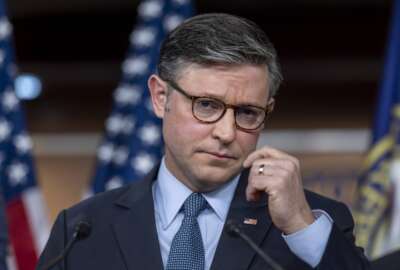With budgets tightening, DHS alters approach
The Department of Homeland Security Secretary Janet Napolitano said today\'s terrorist is more likely to operate alone rather than as part of a 9/11-type of...
wfedstaff | June 4, 2015 10:08 am
By Emily Kopp
Reporter
Federal News Radio
The Department of Homeland Security did not spare a cent when it built post-September 11 security systems. But faced with budget cuts, the agency is renewing efforts to manage risk and build partnerships with the public.
Secretary Janet Napolitano said DHS had made progress on all steps recommended by the 9/11 Commission and would be able to prevent a September 11-type of attack today. But the job has gotten harder, as terrorists today are more likely to work alone from either abroad or within U.S. borders.
“They are much more difficult to pick up information about in time to intercept,” she said at an event Wednesday hosted by the U.S. Chamber of Commerce on national security since Sept. 11. And if Congress passes across-the-board budget cuts, DHS may be asked to do that with less money.
“Do you choose among layers of security at chemical sites, or different security risk at mass transit, or channel investment into health care?” asked former DHS Secretary Tom Ridge, who is now chairman of the Chamber’s national security task force. “The needs are unlimited but the resources are not.”
That is a new reality for DHS.
“I had the luxury of serving at a time when they were throwing money at me, throwing resources at me,” said Ralph Basham, who was the commissioner of DHS’ Customs and Border Protection from 2006-2009. “Right now the commissioner and others within the department are looking for ways to manage programs with less resources. It’s very concerning.”
Basham said with 420 million people and 70,000 containers crossing U.S. borders each year, DHS’s mission isn’t getting any easier.
“We’re going to have to reduce size of the haystack and concentrate our efforts on what truly pose a threat,” he said.
DHS already is doing that on a small scale through trusted traveler and shipper programs. But even with the best risk-management systems, Napolitano said the government needs help.
She said DHS would renew emphasis on its public service campaign, called “If you see something, say something,” which encourages people to report questionable behavior. Napolitano unveiled new public service announcements.
Napolitano said the agency was making progress in working with businesses, as well. A new program lets company executives work at DHS temporarily.
“It’s helpful to us and quite frankly it’s helpful to the private sector to have more on-the-ground knowledge of DHS,” she said.
Since Sept. 11, businesses have faced increasingly complex security requirements.
Randy Mullet, the vice president for government relations at the trucking company Con-way, said his company sent him to Washington because it was worried that more security measures would harm business.
“Most of it is brought about by agency parochialism,” he said, noting that his workers carry identification credentials issued by five different agencies. “All of those are based on the same security threat analysis and background checks.”
While problems still remain, Ridge said the government and private sector are building a stronger partnership.
“We need to create a culture of intelligence sharing where everyone feels empowered to hit the send button,” he said. “It’s going from the Cold War culture of ‘need to know’ to the 21st century culture of disclosure: ‘need to share.'”
Ridge said that need would continue long after the 10th anniversary of Sept. 11.
“We wear watches; terrorists have time,” he said. “They’re much more patient than we are. We are going to be at this for a while.”
RELATED STORIES:
Private sector loaning execs to DHS – for free
Senate Democrat budget proposal slashes defense spending
Republican plan would cut $32B from agency budgets
(Copyright 2011 by Federal News Radio. All Rights Reserved.)
Copyright © 2025 Federal News Network. All rights reserved. This website is not intended for users located within the European Economic Area.





